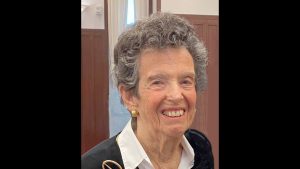Seeking Kin: For Israeli paratroopers, a bond that doesn’t break
Published September 23, 2013
The “Seeking Kin” column aims to help reunite long-lost relatives and friends.
BALTIMORE (JTA) — The photograph shows a lighthearted moment at the end of a war that four decades later still prompts analysis and evokes somber reflections.
Snapped just after Israel and Egypt had signed an agreement ending the Yom Kippur War in February 1974, the photo shows two Israeli soldiers swimming in the Suez Canal.
It was among several several war-era photos from the Israel Defense Forces’ archives published recently by Yedioth Ahronoth as the 40th anniversary of the war neared. The Israeli newspaper asked readers to identify those shown.
Two days later, the swimmers were named: reservists Uri Lahav, a first sergeant, and Amnon Aizenberg, a private, now aged 78 and 68, respectively.
They had jumped into the water to cross from the canal’s west bank to the Sinai Peninsula — approximately one-sixth of a mile. They did so, Aizenberg told JTA recently, to show “that we can swim in the Suez, not just fight for it.”
Aizenberg didn’t even know how to swim, so he was grasping Lahav’s waist to be pulled across. Lahav was far more comfortable in the water, having worked as a commercial fisherman before settling into a 40-year career as an economist with the Egged bus cooperative until retiring in 2005.
Within hours of their dip they were back home: Lahav in Herzliya and Aizenberg in Petach Tikvah.
Their 66th Paratrooper Brigade, 55th Regiment had fought legendarily in the battle for Jerusalem’s Ammunition Hill in the Six-Day War in 1967. In the intervening decades, the unit’s members have maintained contact and gather regularly.
On Oct. 17, many will make their way to Kibbutz Givat Haim for a memorial service marking the 40th yahrzeit of a regiment member.
Right before Yom Kippur, as is their practice, many unit members attended the annual service for 1973 paratrooper fatalities held at the paratrooper memorial near the Tel Nof Air Force Base. And in July, the regiment’s deputy commander, Doron Mor, a geologist, led a group tour of volcanic rock formations close to Mount Avital, near the Golan Heights battlefields.
Unit members are invited to the simchas of their comrades. And they organize events at Hanukkah, Passover and during the summer.
“We’re like a family,” Aizenberg said.
The gatherings are meaningful but not all fun.
Attending events related to the four wars in which he fought – the 1956 Sinai campaign, the Six-Day War, the Yom Kippur War and the first Lebanon War — “are, for me, not happy” occasions, Lahav says. “Many close friends were killed.”
In Lebanon in 1981, Lahav’s son Omer, also a paratrooper, was fighting elsewhere in the country. And now Omer’s daughter, Yael, is serving along the Israel-Egypt border, an area that has experienced attacks on Israelis in recent years but otherwise has remained peaceful as a consequence of the 1979 peace treaty signed by the two countries.
Family associations with battle also figure prominently for Aizenberg, who still repairs heavy construction machinery as he did in the 1970s.
On the eve of Yom Kippur in ’73, just before sundown, military officials knocked on his door to call him into service with war imminent. Aizenberg was sitting shiva: His mother, Dvora, had been killed in a car accident a few days earlier. And his wife, Rachel, was seven months pregnant with their first child.
Aizenberg’s commander, Yossi Yaffe, would be injured during the battle for the city of Suez. (Yaffe later would be killed in battle, one of 2,656 Israeli soldiers to die in the war). Yaffe was sent back to Israel to be treated, and upon returning to the unit in December, he informed Aizenberg that Rachel had just given birth to a son. The Aizenbergs named him Eyal.
In Suez that night, “we were able to light the candles of Hanukkah and had a table set up with food for the holiday, including sufganiyot,” the Israeli donuts, Aizenberg recalled. “The next day, they let me fly home” to briefly spend time with his expanded family.
Eyal now has three children. Aizenberg’s daughter, Yifat, has one.
Aizenberg says he has no illusions that his grandchildren will live in an Israel that’s at peace because the enemy surrounding countries will not allow the Jewish state to let down its guard.
“This is our history, and this is our neighborhood,” he said. “I educate [my grandchildren] to be brave soldiers who understand that they need to protect our country.”
Please email Hillel Kuttler at [email protected] if you would like “Seeking Kin” to write about your search for long-lost relatives and friends. Please include the principal facts and your contact information in a brief email. “Seeking Kin” is sponsored by Bryna Shuchat and Joshua Landes and family in loving memory of their mother and grandmother, Miriam Shuchat, a lifelong uniter of the Jewish people.
![]()














